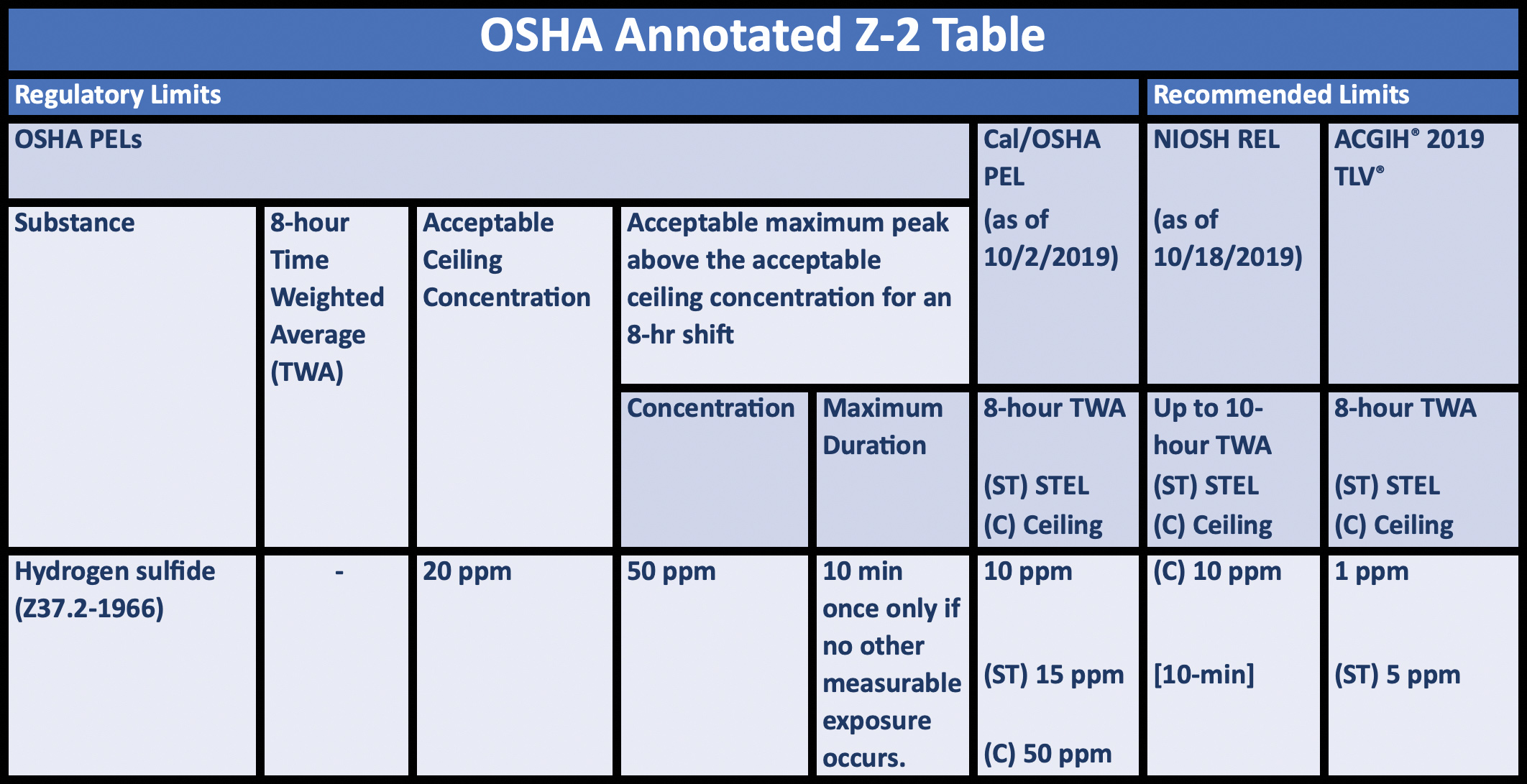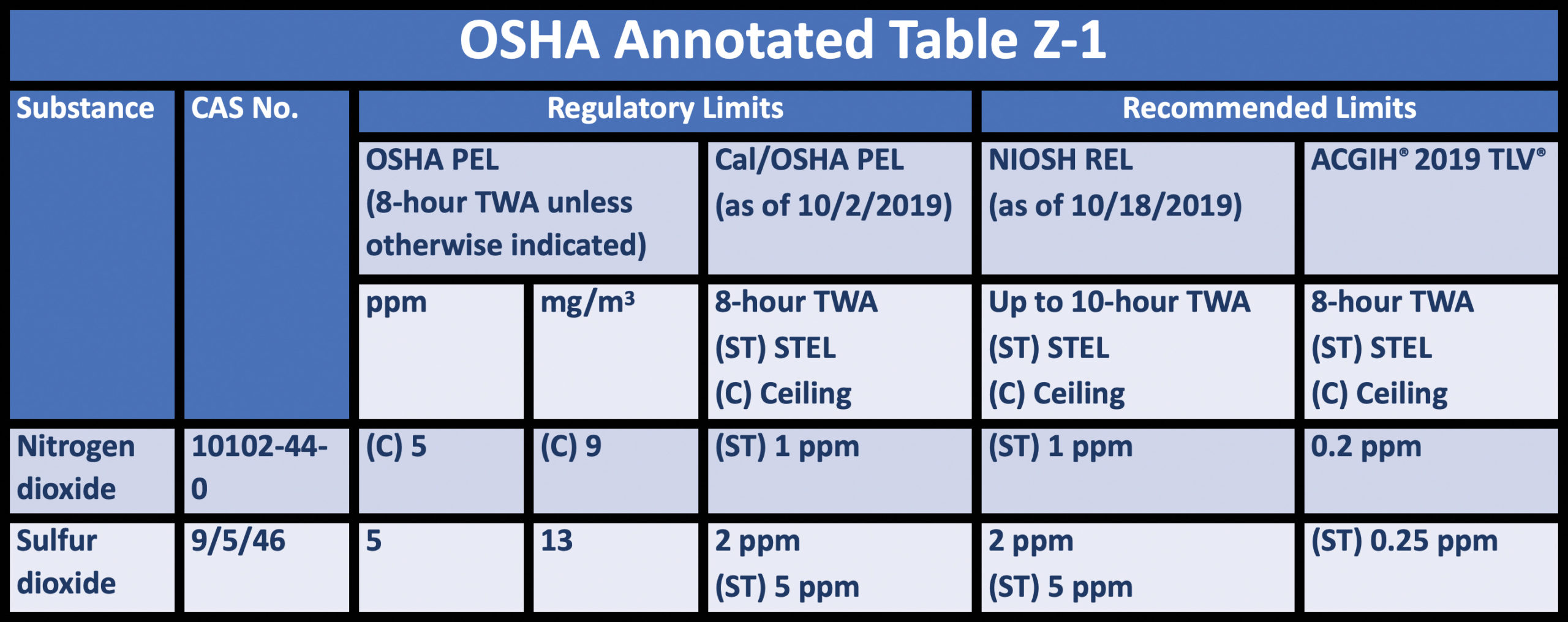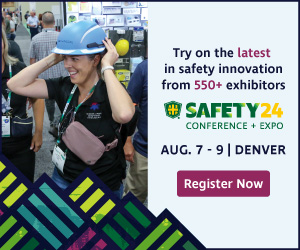Limits for Air Contaminants: 1910 Subpart Z
By: Bob Henderson, Contributor
“Federal and state regulations define the PEL for toxic contaminants, but do not specify how to set the alarms. Gas detection customers depend on manufacturers for guidance. The annotated Z-1 tables provide a side-by-side comparison that allows GfG to provide advice based on best practice as well as minimum requirements specified by OSHA.” GfG Instrumentation, Inc, 800-959-0329, www.goodforgas.com
Setting Alarms & Conforming with Exposure Limit Requirements
OSHA recognizes that many of the permissible exposure limits (PELs) in Table Z-1 “Limits for Air Contaminants” are outdated and inadequate for ensuring protection of worker health. To provide employers, worker and other interested parties with a list of alternate occupational exposure limits that may serve to better protect workers, OSHA has annotated the existing Z-Tables with other selected occupational exposure limits (https://www.osha.gov/annotated-pels/table-z-1).
The annotated tables provide a side-by-side comparison with the California Cal/OSHA PELs, NIOSH Recommended Exposure Limits (RELs) and the ACGIH TLVs®. While the tables explain the statutory exposure limits, they do not directly provide advice as to how users of direct reading instruments should set the alarms. Fortunately, the ACGIH “Guide to Occupational Exposure Values” provides additional guidance.
History

How you set the alarms in your gas detectors is a critical part of keeping workers safe. OSHA has annotated the Air Contaminant Z-Tables to clarify the differences between exposure limit guidelines and to help instrument users understand what is needed. (photo courtesy Adobe Stock.)
The Occupational Safety and Health Act was enacted by Congress in 1970. Most American workers nowadays were not even born when the OSH Act was signed into law! The Act created the Occupational Safety and Health Administration (OSHA) and the National Institute of Occupational Safety and Health. NIOSH was established to provide research and recommendations in the field of occupational safety and health which would later be incorporated into the rules and standards enforced by OSHA. The goal then and now is to ensure that employers provide employees with a workplace free from recognized hazards such as toxic chemicals, noise, heat stress, mechanical hazards and unsanitary conditions.
OSHA regulations use the term Permissible Exposure Limit (PEL) to define the maximum concentration of a listed contaminant to which an unprotected worker may be exposed during his workplace duties. PELs are usually expressed as an eight-hour, time weighted average (TWA) exposure limit. Exposure limits for gases and vapors are usually given in units of parts-per-million (ppm). Limits for mists, fume and particulate solids are expressed in units of mg/m3.
The TWA concept is based on the average exposure over an eight-hour day. Short excursions above the TWA are permitted as long as they do not exceed the short-term exposure limit (STEL) or Ceiling (C), and are compensated by equivalent excursions below the limit. The regulatory TWA calculation is projected over a full eight hours. The OSHA TWA for extended shifts is based on the most recently completed eight hours. Thus, for a worker exposed to 100ppm of contaminant for four hours, the projected eight-hour TWA would be equal to only 50ppm at that time. The TWA for a worker exposed to 100 ppm for a full eight hours is 100ppm. The TWA for a worker exposed to 100ppm of contaminant for 12 hours would still be 100ppm.
Short Term Exposure Limits (STELs) are based on the average exposure over a shorter period. Most STELs are calculated on a 15-minute basis. Ceiling (C) limits are based on a concentration that may not be exceeded for any length of time. The PEL for many contaminants includes both a TWA and a STEL, or a TWA and a Ceiling. Some include only a STEL, or only a Ceiling. When the PEL includes more than type of limit, no part of the exposure limit can be exceeded.
OSHA PELs are listed in Subpart Z (Section 1910.1000) of the Code of Federal Regulations. Subpart Z contains three tables (Z-1, Z-2 and Z-3) which list the contaminants which are specifically regulated by this standard. The PELs were originally issued shortly after adoption of the OSH Act in 1970. The Federal PELs set the highest allowable unprotected workplace exposure limits for these substances. Individual states either follow the Federal regulations, or follow their own, state-specific permissible exposure limits. States may not publish or follow exposure limits that are more permissive than Federal OSHA limits.
The Recommended Exposure Limit (REL) is the name used by NIOSH for the occupational exposure limits (OELs) it recommends to protect workers. NIOSH over the years has been active in the study of chemical hazards and has updated the REL for many airborne toxic contaminants, sometimes more than once, since 1970. Until adopted by OSHA, NIOSH recommendations are not automatically enforceable. However, states are free to incorporate NIOSH recommendations as enforceable under their own state specific laws.
On January 19, 1989, OSHA updated the exposure limits in 29 CFR 1910.1000. OSHA reduced the exposure limits for 212 substances, created new PELs for 164 substances that were not previously regulated, and raised the exposure limit for one chemical. The PELs of 223 other contaminants were either left unchanged or not considered in the rule-making process. The changes were largely based on the NIOSH RELs that were current at that time.
The updated OSHA rule was the subject of several legal challenges, and on July 7, 1992, the U.S. Court of Appeals, Eleventh Circuit, vacated the 1989 PELs. The current versions of the OSHA Z-1000 Tables reflect the Court’s decision. It also explains why there is such a large difference between the OSHA PEL and the NIOSH REL for many toxic contaminants.
State Plans are OSHA-approved workplace safety and health programs operated by individual states or U.S. territories. There are currently 22 State Plans covering both private sector and state and local government workers, and six State Plans covering only state and local government workers. In most of these states, when there is a difference between the OSHA PEL and the NIOSH REL, the enforceable exposure limit in the state is tied to the more conservative of the two limits. In some states the limits are based on the (usually) even more conservative American Conference of Governmental Hygienists (ACGIH) Threshold Limit Value (TLV®). Sometimes states modify their exposure limits based on their own findings. California has taken this approach with several state specific PELs.
The ACGIH TLVs are among the world’s most widely used and respected guidelines for workplace exposure to toxic substances. TLVs are developed and designed to function as recommendations for the control of health hazards, and to provide guidance intended for use in the practice of industrial hygiene. Although ACGIH TLVs are not expressly developed for use as legal standards, they are frequently incorporated by reference into state, federal, and many international regulations governing workplace exposure. They may also be cited or incorporated by reference in consensus standards of associations such as the National Fire Protection Association (NFPA), or American National Standards Institute (ANSI).
Individual employers are in much the same position as states when it comes to workplace exposure limits. Employers can either follow the official limits; or follow their own more conservative guidelines. Given the potential for lawsuits, many employers have made the strategic decision to base their corporate health and safety programs on the most conservative applicable recognized standards. Since ACGIH recommendations are frequently more conservative than OSHA PELs and NIOSH RELs, many programs, especially the programs of prominent multinational corporations, use the ACGIH TLVs. Some of the most conservative corporations limit exposure to one-half of the of the published REL or TLV.
Strategies for Setting the Alarms in Real-time Atmospheric Monitors
Even when it is clear which exposure limits apply, deciding how to set the alarms can be a difficult decision. The OSHA PEL, NIOSH REL and ACGIH TLV specify exposure limits for unprotected workers, but do not tell instrument users how to set the alarms in their real-time instruments. The alarms have two purposes: to ensure that the exposure limits are not exceeded and to alert workers if conditions begin to become unsafe. Alarms need to be activated under conditions that allow workers to self-rescue.

Most OSHA PELs have never been updated since the passage of the Occupational Safety and Health Act back in 1970. NIOSH RELs and ACGIH TLVs are regularly updated, and increasingly more conservative than the PELs. Some would say too conservative. One of the reasons that there has been so much pushback against the newer, more conservative exposure limits is worry about how to set the alarms. Instrument users (and sometimes regulators) often believe they need to set the instantaneous “low” alarm at the TWA limit. Fortunately, this is not the case.
Real-time atmospheric monitors have multiple alarms tied to the concentration of the gas being measured. Some alarms can set by users, while others are set by the manufacturer, or required by the certifications carried by the instrument. Most real-time toxic gas instruments have at least four user settable alarms; a “low” instantaneous (peak) alarm, a “high” alarm (also based on the peak reading), a STEL alarm based on the most recent 15 minutes of exposure, and a TWA alarm based on the average exposure projected over a full 8-hour shift. For extended shifts, most instruments calculate the TWA alarm according to OSHA and ignore exposure prior to the most recent eight hours.
When the exposure limits are high compared to the range and resolution of the instrument, an easy approach is to set the instantaneous low and high alarms at the TWA and/or STEL limit values. Setting the instantaneous low alarm at the TWA is extremely conservative. Taking this approach was easier in the past when exposure limits were higher. It is much more difficult to take this approach with the latest REL and TLV exposure limits for several important contaminants, including H2S, SO2 and NO2. It is not always feasible to set the instantaneous alarm at the latest TLV-TWA limit.
The annotated OSHA Z-Tables (https://www.osha.gov/annotated-pels/table-z-1) make it easier to understand the differences between the major exposure limit guidelines; and decide on the optimal approach to setting alarms. Consider the H2S exposure limits listed in the Z-2 Table: OSHA Annotated Table Z-2.
The most common alarm settings used by instrument manufacturers and users follow the reasoning behind the Cal/OSHA PEL, (as well as guidance contained in OSHA 1910.146 “Permit Confined Spaces”). The instantaneous (peak) low alarm is typically set at 10ppm, the high alarm is set at 15 ppm, the STEL alarm is set at 15 ppm, and the TWA alarm is set at 10ppm.
It is a little tougher for instrument users who are required to follow the TLV. The 2012 H2S TLV consists of a TWA limit of 1.0 ppm, and a STEL limit of 5.0 ppm. Setting the instantaneous “low” alarm at 1.0ppm can lead to frequent nuisance alarms due to short term transients above 1.0ppm. Also, setting
the low alarm at 1.0 may not even be possible for many instrument designs.

The ACGIH provides some useful guidance for setting alarms in the 2021 “Threshold Limit Values (TLVs) and Biological Exposure Indices (BEIs)” handbook. The handbook notes that for many substances with a TLV–TWA, there is no TLV–STEL or Ceiling. Nevertheless, short-term peak exposures above the TLV–TWA should still be controlled. According to the guidance, transient exposure levels may exceed up to 3 times the value of the TLV–TWA level for up to 15 minutes at a time, on up to four occasions spaced at least one hour apart during a workday. Under no circumstances should transient exposure levels exceed 5 times the value of the TLV–TWA level when measured as a 15-min TWA.
In other words, a valid alarm strategy would be to set the “low” alarm at 3X the TWA and the “high” alarm at 5X the TWA, while setting the TWA alarm at the actual TLV-TWA limit value. So, for employers and instrument users who follow TLV exposure limits, the instantaneous (peak) low alarm is set at 3.0ppm, the high alarm is set at 5.0ppm, the STEL alarm is set at 5.0ppm, and the TWA alarm is set at 1.0ppm. Because the TWA is calculated on an 8-hour basis, short term transients and/or fluctuations in the readings have little effect on causing false alarms. Most real-time H2S instruments can be used with the TWA alarm set to 1.0ppm.
The same issues apply to other contaminants like NO2 and SO2. Having the exposure limits side-by-side in the annotated tables makes it much easier to develop a prudent alarm setting strategy.
Conclusions and Advice
- Make sure to define the objectives behind the use of your real time instruments. It is critical that the instruments you use are “fit for purpose.” The instrument capabilities need to match your requirements, and the instrument settings need to match your objectives.
- Make sure you have sufficient resolution and accuracy. If you need to set the alarms in your NO2 instrument at 0.2ppm, you better not be using an instrument that limits the resolution to 0.1ppm.
- Make sure you understand the effects of ambient conditions on readings. Temperature, pressure, and humidity can have an effect on readings. Make sure you are aware of the effects of interfering contaminants as well. For instance, the presence of NO2 can cause SO2 sensors to read negative, while the reverse is true as well.
- If one of your requirements is to log your results and generate reports, make sure the datalogging capabilities of the instrument meet your objectives.
- Make sure you and your instrument users are well trained. Make sure to read the Owner’s Manual.
- Fresh air adjust your instrument before each day’s use; test and calibrate according to statutory and manufacturer requirements; make sure that you follow proper procedures; and document what you are doing.
Share on Socials!
Living & Thriving in a Pandemic: How to Manage a Safe Return to Work
Heat Stress Assessment & Prevention
ANSI/ISEA Z89.1-2014: Head Protection Guidelines
Leaders in Industrial Hygiene
Council for Accreditation in Occupational Hearing Conservation (CAOHC)
Subscribe!
Sign up to receive our industry publications for FREE!










